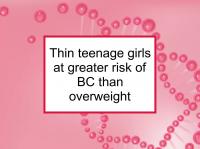Girls who grow quickly during childhood and reach an above-average height are at greater risk for breast cancer in adulthood than shorter girls. Growth hormones (rather than estrogen) drive this risk factor, starting in the womb. In fact, it is the tall, slender girls that are most likely to develop breast cancer in later life.
Overweight girls are less likely to develop breast cancer, despite the fact that they may enter puberty at a young age and that early puberty is also a risk factor for breast cancer. Now a large new Israeli prospective study has reported that being overweight during the teenage years may protect against premenopausal breast cancer.
Tall, slender girls have higher risk of breast cancer adulthood
High birth weight is associated with tall stature in childhood and adulthood, which in turn are associated with increased risk of breast cancer. However, it is above-average height, not weight, that is the risk factor. Being overweight at age seven was found to be associated with lower postmenopausal breast cancer risk than a slender body type in one Swedish study. A Danish study reported that high birth weight, tall stature as of age 14, low body mass index (BMI) at age 14, and peak growth at an early age all were independent risk factors for breast cancer. Rapid increase in height during puberty (eight to 14 years of age) were also positively associated with breast cancer. In other words, it is the tall, thin girls with early growth spurts who are at most risk for breast cancer in adulthood.
Early first period (menarche) is known to increase the risk of breast cancer in adulthood. First period tends to take place earlier in girls who had a low birth weight, who were heavy compared to their peers at age seven, and/or who were tall compared to their peers at age seven.
Thin girls who experience a rapid growth spurt (leading to tall stature in adulthood) are also more likely to develop benign fibrocystic breast disease (itself a risk factor for breast cancer) in adulthood than short or overweight girls. One study reported that being overweight during childhood and being short as an adult both were associated with lower risk of benign breast disease. Girls who experienced the most rapid height increases were had twice the risk of benign breast disease compared to those with the slowest growth. Another study found that, contrary to expectations, later age of menarche was not protective against benign breast disease. This finding is consistent with other studies that have reported that benign breast disease patients are not protected against breast cancer by later menarche.
Latest research finds adolescent thinness linked to increased risk
The prospective study referenced at the beginning of this news story was designed to investigate the association between BMI in adolescence and breast cancer risk according to menopausal status. The study included 951,480 Jewish Israeli women whose height and weight were measured at age 16 to 19 during the period 1967 to 2011. Participants were followed through year-end 2012. A total of 9,619 breast cancers were diagnosed during 18,078,941 person-years of follow-up, including 4,901 premenopausal, 3,809 perimenopausal, and 909 postmenopausal cases.
Compared to a "healthy" BMI (5th to 85th percentiles) and adjusted for country of origin, education, and height, adolescent BMI tended to be negatively associated with breast cancer risk. Overweight (85th to 95th percentiles) teenagers had an 8% lower risk of breast cancer and obese (at least 95th percentile) teenagers had a 32% lower risk. The risk of breast cancer was approximately 6% higher in underweight girls (BMI < 5th percentile), but this result did not reach statistical significance.
When the data was analyzed according to age at diagnosis, only the associations for premenopausal breast cancer were statistically significant. Women who had been underweight during adolescence had a 15% increased risk of premenopausal breast cancer, whereas those who had been overweight or obese had significantly lower risk. The authors conclude that adolescent thinness is associated with increased risk of premenopausal breast cancer. Overweight and obesity during the teenage years appear to be protective of premenopausal but not postmenopausal breast cancer. This finding suggests a causal role for adult weight gain in perimenopausal and postmenopausal breast cancer.
Please see our article on protecting our daughters from breast cancer for more information.
